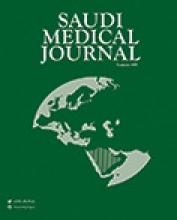Abstract
OBJECTIVE: To describe clinical characteristics, interventions required, and outcome of critically ill obstetric patients admitted to a general intensive care unit (ICU).
METHODS: All obstetric patients admitted to ICU at Armed Forces Hospital, Riyadh, Kingdom of Saudi Arabia from 1997 to 2002 were included in the study. The data related to demographics, obstetric history, pre-existing medical problems, indications for ICU admission, intervention required, length of stay, and outcome of ICU admission were collected by retrospective review of medical records.
RESULTS: The 99 obstetric admissions to ICU were represented by 0.2% of all deliveries and 1.6% of all ICU admissions. Most patients were young (median age of 30 years) with parity (median) of 3 and stayed in ICU for an average of 2 days. All except one patient were admitted during the postpartum period. The majority (76%) were admitted after cesarean section. Obstetric hemorrhage (32%) and hypertension (29%) were the 2 most common indications for admission. The majority (59/99) of patients also had pre-existing medical problem and most common (16/59) was rheumatic heart disease. Preeclampsia (23/99) and eclampsia 10/99 were the most frequent obstetric complication. Thirty-six percent of our patients required ventilatory support. In the majority of patients, direct arterial (81%) and central venous (73%) pressure monitoring was carried out. Pulmonary arterial and left atrial pressure was monitored in 4%. Almost one third of patients received antihypertensive therapy. Inotropic support was given to 9% and blood (and its products) was given to 46% of patients. Antibiotics (28%) and magnesium sulphate (25%) were the most frequently used medicines. Out of the total 99 admissions, one patient died and 16 patients developed complications.
CONCLUSION: In our survey, the 2 most common indications for admitting obstetric patients to ICU were hemorrhage and hypertension. Invasive hemodynamic monitoring and ventilatory support are the 2 main interventions. Improving quality of care before and after admission to ICU may reduce maternal morbidity.
- Copyright: © Saudi Medical Journal
This is an open-access article distributed under the terms of the Creative Commons Attribution-Noncommercial-Share Alike 3.0 Unported, which permits unrestricted use, distribution, and reproduction in any medium, provided the original work is properly cited.






